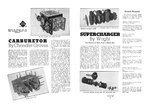MiTasol
2nd Lieutenant
Because some of us are either younger and do not have a knowledge of the basics of Engine design and therefore do not know how that directly affects airframe design, or are who are older but do not have the vast hands on experience that others have, I am posting this copy of the above publication.
According to Worldcat (a catalog of many of the worlds top libraries) the original was printed in 1942, there was a 1943 revision and 1949 revision. This particular copy was printed in Australia in 1945 but appears to be essentially a copy of the 1943 US manual.
The 1942 version in black and white can be found at Some fundamentals of aircraft engine design (with particular reference to the requirements for performance at varying altitudes) but is a Google scan with all the issues that go with those publications.
The 1943 version in black and white can be found at Engine design as related to airplane power : with particular reference to performance at varying altitudes. but is a Google scan with all the issues that go with those publications. In general it is clearer than my copy.
My copy was downloaded several years ago from another site that I cannot remember and I spent hours de-skewing the pages, fixing the darkness at the fold lines, removing graffiti. etc. Unfortunately I could not do anything about the original poor quality of some pages.
I have, as always now, added a ww2aircraft watermark to stop unscrupulous scum selling it from their websites.
According to Worldcat (a catalog of many of the worlds top libraries) the original was printed in 1942, there was a 1943 revision and 1949 revision. This particular copy was printed in Australia in 1945 but appears to be essentially a copy of the 1943 US manual.
The 1942 version in black and white can be found at Some fundamentals of aircraft engine design (with particular reference to the requirements for performance at varying altitudes) but is a Google scan with all the issues that go with those publications.
The 1943 version in black and white can be found at Engine design as related to airplane power : with particular reference to performance at varying altitudes. but is a Google scan with all the issues that go with those publications. In general it is clearer than my copy.
My copy was downloaded several years ago from another site that I cannot remember and I spent hours de-skewing the pages, fixing the darkness at the fold lines, removing graffiti. etc. Unfortunately I could not do anything about the original poor quality of some pages.
I have, as always now, added a ww2aircraft watermark to stop unscrupulous scum selling it from their websites.
Attachments
Last edited:

